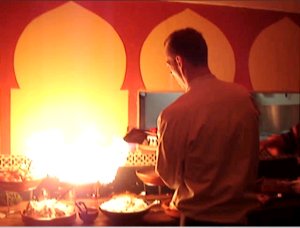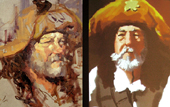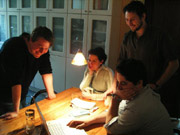We’ve been talking about reading modes, but let’s imagine, for a moment, that the future book will change reading itself. Perhaps it will combine the performance aspects of television, film, animation, and theatre with the interactive aspects of the world wide web to forge a book that reads you as you read it.
Science fiction writer Neal Stephenson imagines such a book in his novel, The Diamond Age. The main character is a book–an illustrated primer that functions almost like an artificial intelligence. It bonds with its reader, notices things about her life, and uses those bits of information to create instructional narratives on the fly. These stories are performed by live “ractors” (human actors working in reactive/interactive scenarios) and broadcast on the pages of a book. The physical book is leather bound, with “smart” paper pages that support electronic text and animated images. The primer looks like an old-fashioned book, but acts (or reacts) like a book of the future. In Stephenson’s imagination, it’s this element of interactivity and performance that distinguishes the future book from its predecessor.
But lest you worry that I’m basing my research on the imaginings of my favorite science fiction writer, I can assure you that the performing book is already here in its nascent incarnations. In the image of Stephenson’s primer, a company called Touchsmart is developing a book with “smart” paper that functions like a touch screen, allowing readers to find answers to their questions instantly, through a wireless connection to the internet and to other electronic devices that broadcast content.
Publisher, Peak Interactive Books, whose stated mission is to, look beyond the print book, beyond television, beyond the web page, to the interactive book of the future, is publishing interactive multimedia textbooks including: Cryosurgery for Prostate Cancer, and Using Interactive Media to Communicate.
The interactive CD Roms published by Voyager are an excellent touchstone in the history of performing books. TK3 software, which has been used to make everything from textbooks, to performing paintings, also draws on the performing book model. The institute is presently developing “Sophie,” ebook authoring software that will allow most currently available media to be incorporated into an electronic book.
As for the book reading you. Ben’s recent post “finally, I have a Memex!” describes how the semantic web will add a new dimension to the growing power of search engines. Their ability to collect personal information has already been incorporated into the recreational and academic reading experience. What we are waiting for is the book that builds its content out of the bits it gathers from our lives.
Author Archives: kim white
fantasy ebook
I’m still thinking about Steven Pemberton’s estimation of when and why the shift from paper book to ebook will occur. Perhaps we, the book loving public, are waiting for something more than just a perfect screen. The question is, what, exactly, are we waiting for? What would it take to make the ebook absolutely irresistible? To follow is my attempt to imagine the perfect ebook.
First, I want to read ebooks on a beautiful portable device. Smaller than my laptop, larger than my palm pilot (about the size and weight of an actual book). The cover should be soft leather that, when folded back, reveals a flawless screen with jewel-like resolution. I want to be able to store all the books I own in this “book” so that when I go on vacation, or when I go to work, or when I go to an artist colony, I can read whatever I’m in the mood for. If I happen to be driving my car, or cooking, or gardening, or if I happen to be blind, I want to be able to tell my book to read to me.
If I am taking a class on a particular book, or teaching a class on a particular book, I want to be able to access all the scholarly work that applies to that book. Furthermore, I want to be able to search all notations made on the passages I am interested in. And I want to be able to search the book itself: to copy and paste quotations into my paper (instead of having to retype them). I also want to be able to add my scholarly work to the corpus that is building around the book I am studying.
If I am looking for a new book to read, I want to be able to look at reviews and excerpts. I want to be able to access recommended reading lists that have been posted online by people whose taste I respect.
If I suddenly decide I want to read a book that is not part of my collection, I want to be able to download it from the internet through this device any time of day or night because I don’t feel like going to the bookstore.
Also, I need this device because I want to read all the newfangled multimedia ebooks that are coming out which combine text, image, video, and sound. I want to be able to “read” books that were written by visual artists in collaboration with writers and musicians. I want to be able to watch music videos that are starting to look like movies, movies that are beginning to read like books, and books that are morphing into songs.
If I really love a certain book, I want to be able to go to a blog where other people who love this book are talking about it. If there is a movie based on the book, I want to be able to download the movie and watch it on my leather bound electronic “book.” Also, my book should have a keyboard that slides out on the side, or it should have a touchscreen that I can write on, because I might want to make notes in the margins.
And I guess my book should have addresses, phone numbers, a calendar, and pictures of my son. It should allow me to surf the internet, send emails, listen to music, and type papers, because I don’t feel like carrying a bunch of other devices around.
the book is doomed
 “The book is doomed.” That was Steven Pemberton‘s definitive answer to my musings about the future of the book in the digital age. It was the end of the first day of an international conference on web design, we were at the Friday night conference dinner, eating a crè me brulee that had been set ablaze just minutes before, and I don’t mean the little blue acetylene flame that puffs out after a few seconds. The chef blasted our crè me brulee for several minutes with a torch that looked like something a forest ranger would use to execute a controlled burn.
“The book is doomed.” That was Steven Pemberton‘s definitive answer to my musings about the future of the book in the digital age. It was the end of the first day of an international conference on web design, we were at the Friday night conference dinner, eating a crè me brulee that had been set ablaze just minutes before, and I don’t mean the little blue acetylene flame that puffs out after a few seconds. The chef blasted our crè me brulee for several minutes with a torch that looked like something a forest ranger would use to execute a controlled burn.
So, I’m eating my crè me brulee, trying to understand this pronouncement; when someone like Steven Pemberton says that the book, in the digital age, is doomed, you have to take it seriously. He cites The Innovator’s Dilemma, by Clayton M. Christensen. The thesis, Pemberton explains, has to do with the process of innovation and adoption. A new invention has to find a niche market that will allow it to improve and develop. Once the new invention advances enough to allow it to compete with the entrenched technology it is quickly adopted. This often radically changes an industry. Pemberton gives computer printers as an example. Anyone remember the old dot matrix printers? They had gears on the side that fit into corresponding holes in the paper. Remember how slow they were and how poor the quality was? The introduction of the laser printer made vast improvements in printer quality and as soon as printer technology improved, a revolution in desktop publishing was made possible.
The book, Pemberton contends, will experience a similar sea-change the moment screen technology improves enough to compete with the printed page.
networked book/book as network
Book as Network/Networked Book? That’s the koan I’ve been puzzling for the last few weeks. Can something made from, let’s say, hundreds of semi-anonymous contributors or commentors be considered a book? Is this what the texting generation is going to want–something a little less single-author, a little more…bloggy? The possibility makes me slightly sick and dizzy (I’m still paying student loans for a single-author oriented MFA in creative writing). At the same time it’s kind of exciting. Could, for example, my newest favorite blog Overheard in the Office a spin off of Overheard in New York be considered a dynamic anthology?
What about multi-player game-based narrative formats like Sims; are they the digital equivalent of networked novels? Bob recently sent me a link to an article entitled: Sims 2 hacks spread like viruses. Apparently, hackers have infected the Sims 2 universe, messing with individual games/narratives. About this Bob says: this seems so interesting to me if we consider it as one of the strands of future narrative where the author evolves into a god who creates a universe that people populate and mess with as people do; i.e. that the author creates a starting place for an unfolding story. Of course this has been a visible strand since the advent of computer games, especially the large multi-player ones — but for me the added bit here, that the mortals are messing with the game’s code and thus vastly increasing the scope of the game, brings the whole subject up with renewed interest.
The future book will be a networked book or a “processed book” as Joseph Esposito calls it. To process a book, he says, is more than simply building links to it; it also includes a modification of the act of creation, which tends to encourage the absorption of the book into a network of applications, including but not restricted to commentary.
A modification of the act of creation…what, exactly, does this mean for the craft of storytelling? Is it changing utterly? And is somebody going to tell the MFA programs?
btw. if you know any great examples of networked books let me know. I’m building a collection.
the digital aesthetic: what are we losing?
Much as I love most things digital, I occassionally come across an example of how lacking the virtual still is in comparison to the material. A recent staged showdown between a traditional oil painter and a digital “painter” makes this all too clear. Somehow the digital “painting” just doesn’t have the same vitality as the old-fashioned brush and paint version. Compare, which do you think is better?

I think there is some equivalent for books, but only for really fine books with delicious velvety (or thick toothy) paper, elegant typography, masterful craftsmanship. In short, the book as art object has the kind of appeal that probably will not be userped by its digital counterpart. However, there is a certain excitement to live, electric, dynamic, cinematic, interactive digital media that traditional forms can’t compete with. Maybe the mistake of this “showdown” was to ask digital art to try to be traditional oil painting and what’s the point of that?
One more thing, I will never give up my gorgeous Lynd Ward books, but if a digital version came along full of annotations, images of Ward at work, video or audio clips, biographical information, links to other fans of Ward, etc… I would buy it in a heartbeat.
lunch with alex itin



While we wait for our offices at Columbia, the Institute for the Future of the Book is conducting business in Bob Stein’s kitchen on the upper west side of Manhattan. Though our location affords almost limitless opportunities for cuisine, we have, for various reasons, limited our gustatory experience to three restaurants: Saigon Grill, Miyako Sushi, Pizza Perfecto. This limitation makes choosing what to have for lunch both easier and more difficult at the same time, as no one wants to be the one who cries sushi on a clearly Italian sort of day. So we were all glad when Alex arrived to settle the question. Saigon Grill.
Alex also treated us to a viewing of his latest work-in-progress, an electronic book/hybrid artwork entitled “Willoughby.” Alex uses electronic book technology (TK3, to be exact) to cast his black and white drawings as stage sets into which he embeds video clips of his performance. In the clips, he appears in elaborate make-up enacting bits of Willoughby’s tortured monologue (“I don’t want to die,” is Willoughby’s refrain). As Alex pages through the ebook, he casually narrates the story. This narration creates an engaging framework for the piece.
For a full-on Itin experience, you can download his electronic sketchbooks or visit the exhibitions section of our site for a description of his latest work-in-progress. Why are we so interested in his work? Bob, who has known Alex for some time, describes the progression, “When Alex started to bring his work as a painter into the electronic medium, an impulse to combine those images with sound, video, and narrative, quickly emerged and Alex went with it. It’s interesting to watch an artist follow these impulses to invent a new form of expression.”
another ann arbor thought: borders and google
Ann Arbor is also the birthplace of Borders Books, a megabookstore similar to Barnes & Noble. It started in the 70s as a small used bookstore and evolved into a superstore which, according to their website, serves “some 30 million customers annually in over 1,200 stores.”
The Borders’ website credits their success to, “a revolutionary inventory system that tailored each store’s selection to the community it served.” In other words, they applied small bookstore strategy–get to know the particulars of a customer’s reading habits–on a larger scale. Since Google has chosen Ann Arbor as one locus of its nascent megalibrary, I got to thinking, what might these two distributors have in common (besides A2)? Google might be taking a cue from Borders when it designs the cyberlibrarian to accompany its digital collection. The small bookstore owner learns, through interaction, what a particular community wants. Borders’ inventory system tracked what the client was buying and selling. Google may, likewise, be able to track your buying and selling, your searching and asking. Perhaps the automaton Google librarian will “know” you based on information accumulated by all the various Google searches you have conducted. Problem is, that’s marketing strategy, not educational strategy. Will the Google librarian be able to make intuitive leaps leading the browser to things he/she is not familiar with rather than to more of what he/she already knows? How will search engines answer the need for this kind of expertise?
after a holiday visit to ann arbor: the u of m library & google
I have fond memories of studying in the University of Michigan libraries, (as a high school student, and later as a U of M undergraduate). The physical space of the library, the seemingly endless stacks of books, which allowed deep exploration of even the most obscure topics, and gave me a sense of how vast, (and how limited) the universe of human thought really is. How is this going to be translated in the virtual space of Google’s digital library?
Isn’t it the job of the University library to provide a young scholar with opportunities to “see” the scope of human knowledge? While at the same time, offering a kind of temple space for the engagement of these books. Without the marble staircases, the chandeliers, the stone pilasters, the big oak tables, the reference room, the stained glass windows, the hushed silence, how will we get the message that books are important, and that understanding them requires a particular “space.” The physical space of the library serves as a metaphor and a reminder of the serious mental space that needs to be carved out for productive study. What will we lose when that space becomes “virtual?” Are we “saving” space by putting everything in the computer? Or are we losing it?
tower of babel or trivial pursuit?
Read New York Times Article
In an article in yesterday’s NY Times, Alberto Manguel compares the Genesis story of Babel and the library at Alexandria with their alleged modern-day counterpart–Google’s commitment to digitize all human knowledge. Are we constructing a modern-day tower of Babel? A monument to the hubris of what might be possible if we could just get a little smarter. Will Google help us find answers to the big questions: where did we come from, and what’s the meaning of it all? I went online to find out. I Googled the question “What is the meaning of it all?” and got the following:
Dr. Dial-up
Click here to read more
There is a new initiative underway to make biomedical research immediately available on line and free to the public. According to the Pew Internet & American Life Project, 66% of those with internet access have used it to look for health/medical information. That means that over 85 million Americans (and who knows how many people worldwide) went online last year to doctor themselves. Is this a new kind of do-it-yourselfer, the amateur physician, Google-ing a diagnosis and a cure? And when all of this new “information” becomes available, will the office visit–which the HMOs are already putting the squeeze on–become a thing of the past?
